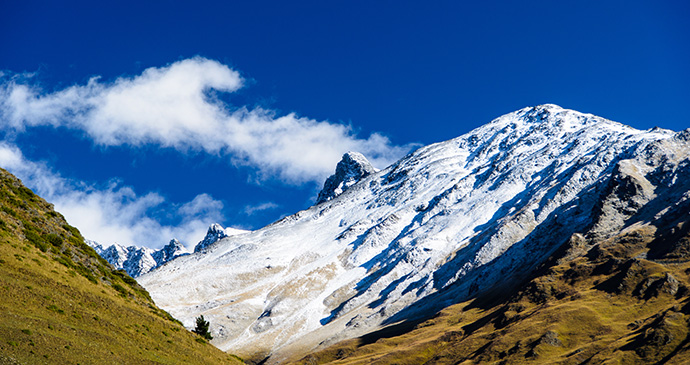The country’s remotest and least spoilt national park is only accessible for a few months of the year.
Just beyond Alaverdi, on the far bank of the Alazani, is Kvemo (Lower) Alvani, a village which in summer is very quiet but in winter acts as home to the bulk of the population of Tusheti, on the far side of the Caucasus watershed. It’s the starting point for travel to this wonderfully remote and scenic area. It’s also the administrative centre for the Tusheti National Park, which comprises a total of 16,297ha in the Tushetis, Batcharis and Babaneuris reserves.
In the Batchara Gorge, north of Akhmeta, there’s a unique forest of yew trees, up to 25m high, 1.2m in diameter and 2,000 years old; this is currently inaccessible due to the problems in the Pankisi Gorge, immediately adjacent.
The Babaneuris Reserve, just northeast of Kvemo Alvani, has yews about 1,000 years old, from 950m to 1,350m altitude. The Tushetis Reserve protects possibly unique virgin forests of pine (2,000–2,200m) and birch (2,300–2,600m). Although the national park is still relatively new, it has managed to support a number of guesthouses in Omalo and Dartlo.
The region of Tusheti was effectively autonomous as a tribal democracy until the end of the 17th century, and a road was not built here until 1978–82. Until the 1940s people here had a totally self-reliant life, growing enough wheat, hops and potatoes to keep them through the winter; they then tried to declare independence from the Soviet Union but were crushed by the Red Army, the men being sent to the army or the gulag and the women and children deported to Alvani, since when they have lived a seasonally migratory life.

The scenery is almost as spectacular as in Svaneti, with peaks up to 4,500m, deep gorges and high waterfalls, and well preserved pine forests of Pinus kochiana. It’s similar in many ways to Svaneti, with traditions of hospitality coupled with building spectacular defensive towers or koshkebi; but, unlike Svaneti, there were never any reports of robberies here.
There’s also plentiful evidence of the survival of animist religion here, with the horns of sacrificed goats or sheep placed on stone shrines or khatebi close to most villages – women are not permitted to approach these shrines (although photography from a distance is fine).
Tusheti delicacies include kotori, a bread with a cheese and potato filling, the hard, dry kalti cheese, the smoked cottage cheese-style dambal kacho and very salty gudiskweli or chogi cheese, made of sheep’s milk in a bag (guda) of sheepskin, with the wool on the inside. In 2017 the top prize at Slow Food’s International Cheese Festival in Italy was won by a guda (not Gouda) cheese from Tusheti. Pork is forbidden in Tusheti – in fact local people won’t eat it the day before they travel to Tusheti as it will still be in their gut.
The Atingenoba Festival is held in Tusheti 100 days after Easter, with bareback horse races and human pyramids; men brew aludi beer (dark, malty and not very strong) in sacred places where no mature women are allowed; in 2017 a brewery began to make beer all summer long, not just for festivals.